Fukuda Denshi Co HLX561 HLX-561 User Manual Manual
Fukuda Denshi Co Ltd HLX-561 Manual
User Manual
EXHIBIT D: User Manual
FCC ID DV8HLX561
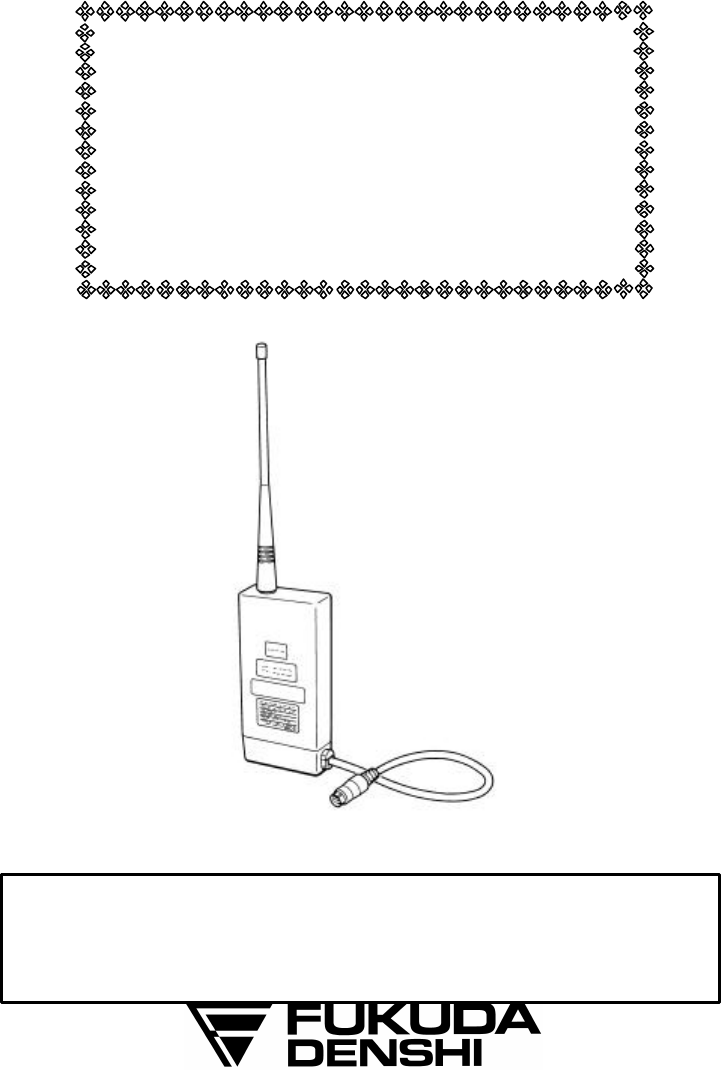
Telemetry Transmitter Module
HLX-561
Operation Manual
Read this manual prior to use of the HLX-561.
Store this operation manual in an easily accessible place near the
unit for future reference.

CAUTION
Federal law restricts this device to sale by or on the order of a
physician.
NOTE: Only a physician or a person under the guidance of a
physician can use this device.
Copyright © 2001 by Fukuda Denshi Co., Ltd.
No part of this document may be copied or transmitted in any form
without the prior written permission of Fukuda Denshi Co., Ltd.
Printed in Japan
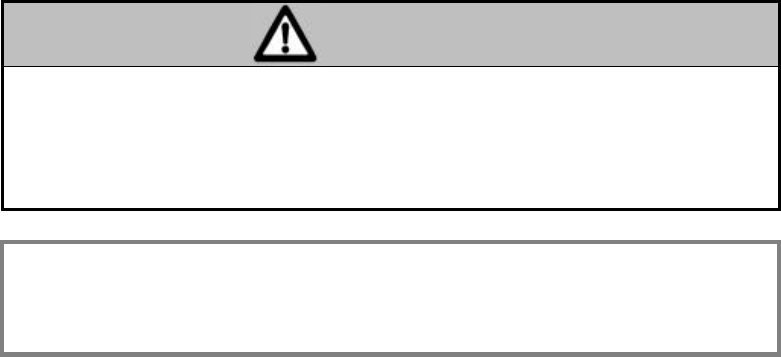
i
Telemetry Precautions
For proper management of the telemetry installation, consult your
Fukuda Denshi representative concerning the following:
• Plan the installation of your telemetry system taking into account
your entire medical facility needs and plant requirements.
• Be sure the antenna system installed meets the facility and plant
requirements.
WARNING
This Radio Frequency device is susceptible to interference
from outside sources. Interference may prevent the
monitoring of patients connected to this device. If problems
exist contact your local service representative.
NOTE : This device operates in the 600MHz UHF band. The exact
frequency of operation depends on designation, and each
individual county's wireless service regulation.
To assure safe and reliable operation, observe the following
precautions:
• Be sure that no other devices are using the frequency assigned to this
transmitter.
• This device is susceptible to interference from electrosurgical knives
and other computerized equipment. If problems occur contact your
local Fukuda Denshi service representative.
• Any obstruction such as reinforced concrete or large metallic surfaces
between the receiver and the transmitter can affect reception. If
problems occur contact your local Fukuda Denshi service
representative.
• When the low battery alarm is present at the central monitor, charge
the battery in the patient monitor.
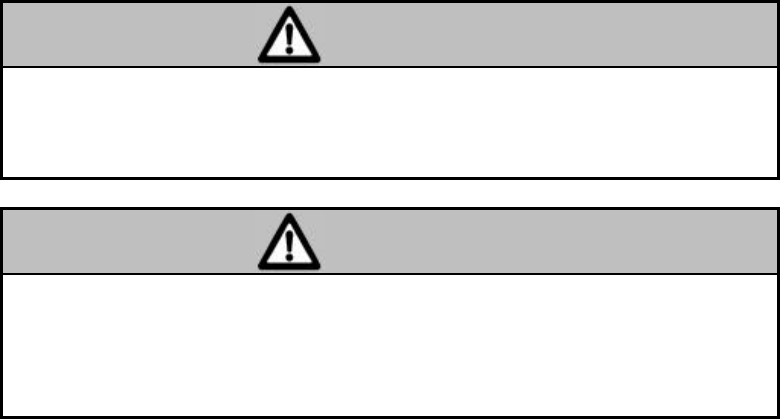
ii
CAUTION
Users are advised to periodically contact the FCC or specified
frequency coordinator and determine if other or your
transmitter frequencies that may cause interference.
CAUTION
The manufacturers, installers and users of Wireless Medical
Telemetry System equipment are cautioned that the operation
of this equipment could result in harmful interference to other
nearby medical devices.

iii
Thank you for purchasing the HLX-561 telemetry transmission module
from Fukuda Denshi. Before use, read this operation manual
thoroughly for correct handling and operation. If you are familiar with
a similar type of product, it is recommended this operation manual be
read and understood since the HLX-561 has unique operation and
handling methods.
Safety Information and Messages
Be sure to observe the warning and cautionary messages related to
important safety information. These instructions are described under
the following message headings. Understand the meaning of the
different types of messages while reading this operation manual.
WARNING
Erroneous operation by failure to observe
instructions when this message is printed
may result in death or serious injury to the
patient, operator, or create a fire hazard.
CAUTION
Erroneous operation by failure to observe
instructions when this message is printed
may result in injury to the patient or
operator, or may cause damage to the
HLX-561 and/or related instruments.
NOTE A NOTE is not a warning instruction but
offers information for correct use of the
HLX-561 to avoid erroneous operation.

iv
Safety Considerations in Using Medical Electrical
Equipment
Contents described here are general safety considerations to be taken
for proper operation of medical electrical equipment and for the safety
of both the patient and operator. Safety considerations specific to the
use of the HLX-561 telemetry transmission module are described on
the next page.
CAUTION
1. Do not use the equipment unless familiar with its operation.
2. Observe the following when installing or storing the
equipment:
• Select a place where the equipment may not be contaminated
with splashing water.
• Consider the atmospheric pressure, temperature and humidity
and provide adequate ventilation. Avoid direct sunlight. The
equipment should not be installed or stored in a location where it
may be adversely affected by air containing dust, saline or sulfur.
• Avoid inclination, vibration and shock, even during transport to
ensure stable operating conditions.
• Do not install or store the equipment where chemicals are stored
or gases are generated.
3. Precautions before Operation
• The equipment is not designed to be explosion-proof. Do not use
the equipment in the presence of flammable gasses or
anesthetics.
• Make sure the equipment is operating safely and normally at all
times.
Ensure that all cords and cables are correctly connected.
• Improper use of multiple instruments simultaneously may result
in erroneous information or lead to a hazardous accident. (Refer
to the Section 9.)

v
CAUTION
4. Precautions during Operation
• Do not to operate the equipment beyond the time period
necessary that is required for diagnosis, monitoring or treatment.
• Observe the equipment and patient constantly for any
abnormality.
• If the equipment or patient indicates any abnormality, stop the
equipment from operating or take proper measures (e.g.
disconnect transducers and electrodes) to ensure patient safety.
• Instruct the patient not to contact the equipment.
5. Cares after Operation
• Disconnect cords and cables by holding the connector plugs. Do
not apply excessive force to cords and cables by pulling to
disconnect.
• Keep the equipment clean in preparation for the next use.
6. If the equipment gets out of order, ensure patient safety by
immediately turning the equipment off and disconnecting
electrodes and or transducers from the patient.
Contact your nearest Fukuda representative and label the
device as "OUT OF ORDER".
7. Do not disassemble or attempt service on the equipment.
Contact your nearest Fukuda Denshi representative for
service.
8. Maintenance and Inspection
• Be sure to perform periodic inspection of the equipment and
accessories.
• Before operating the equipment which has not been used for a
long period of time, make sure that the equipment operates
normally and safely.
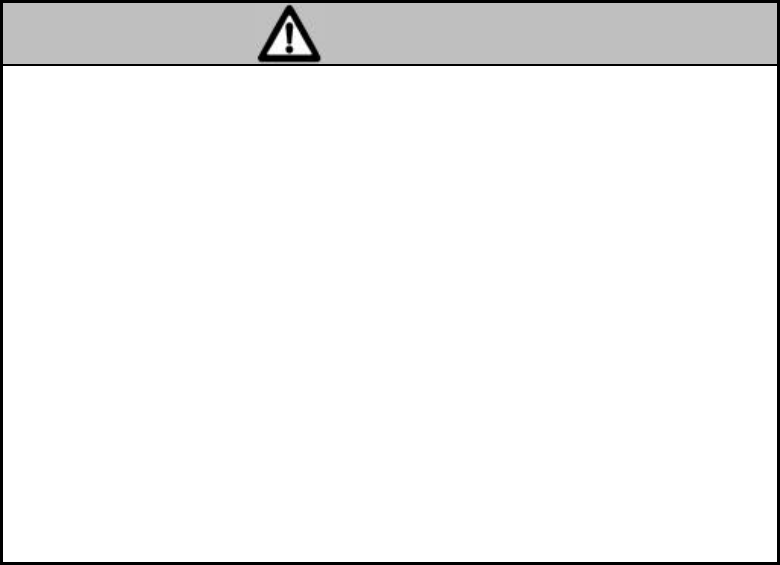
vi
CAUTION
9. When using an electrosurgical unit or defibrillator in
conjunction with this equipment, take care of the following.
• The high-frequency energy produced by electrosurgy equipment
may result in burns to the patient or possible damage to the
equipment. Be sure to observe the precautionary instructions
described in the operation manual of the electrosurgical unit.
• Some types of equipment may be damaged by the energy
discharged by a defibrillator. Ensure a thorough understanding
of the precautionary instructions described in the operation
manual of the equipment before using a defibrillator.
• Some types of equipment other than electrosurgical units and
defibrillators may cause accidental hazards to the patient and
operator when operated under adverse conditions. Read the
operation manual attached to each individual unit and understand
the precautionary instructions prior to use.
Contents
Telemetry Precautions i
Safety Information and Messages iii
Safety Considerations in Using
Medical Electrical Equipment iv
1. General Description 1
2. Controls and Indicators 2
3. Mounting the HLX-561 to the Bedside Monitor
Mounting into the DS-5100 4
Mounting into the DS-5300 7
4. Setting the Receiving Channel of the Monitor 10
5. Cleaning, Sterilization and Disinfection 11
6. Maintenance and Inspection 12
7. Specifications 14
8. Accessories 16
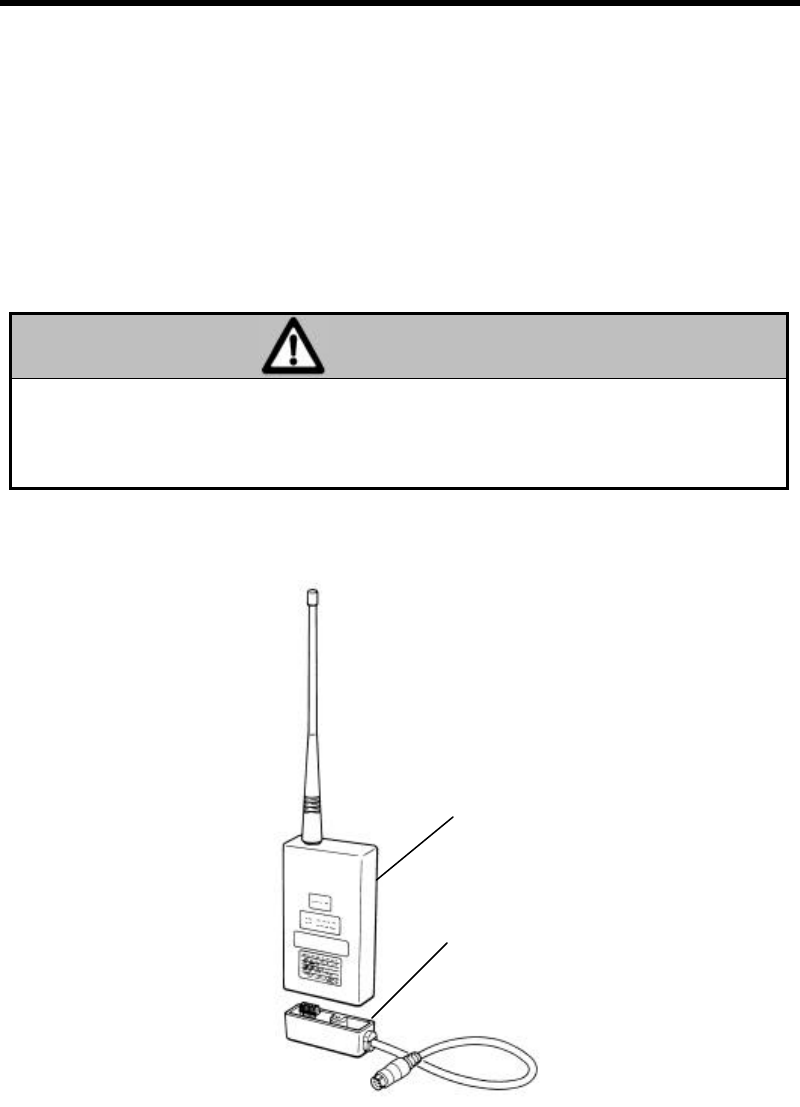
1
1. General Description
The HLX-561 is a telemetry transmission module to transmit
physiological parameters monitored by a bedside monitor in the
DS-5000 series via wireless technology. Thus, the HLX-561 allows the
user to configure an integrated telemetry patient monitoring system in
combination with a central telemetry receiver and central monitor such
as the DS-5800N.
For compatibility with monitors other than DS-5000 series, contact
your Fukuda Denshi representative.
WARNING
Operation of this equipment requires the prior coordination
with a frequency coordinator designated by the FCC for the
Wireless Medical Telemetry Service.
External
Appearance
HLX-561
OA-287(option)
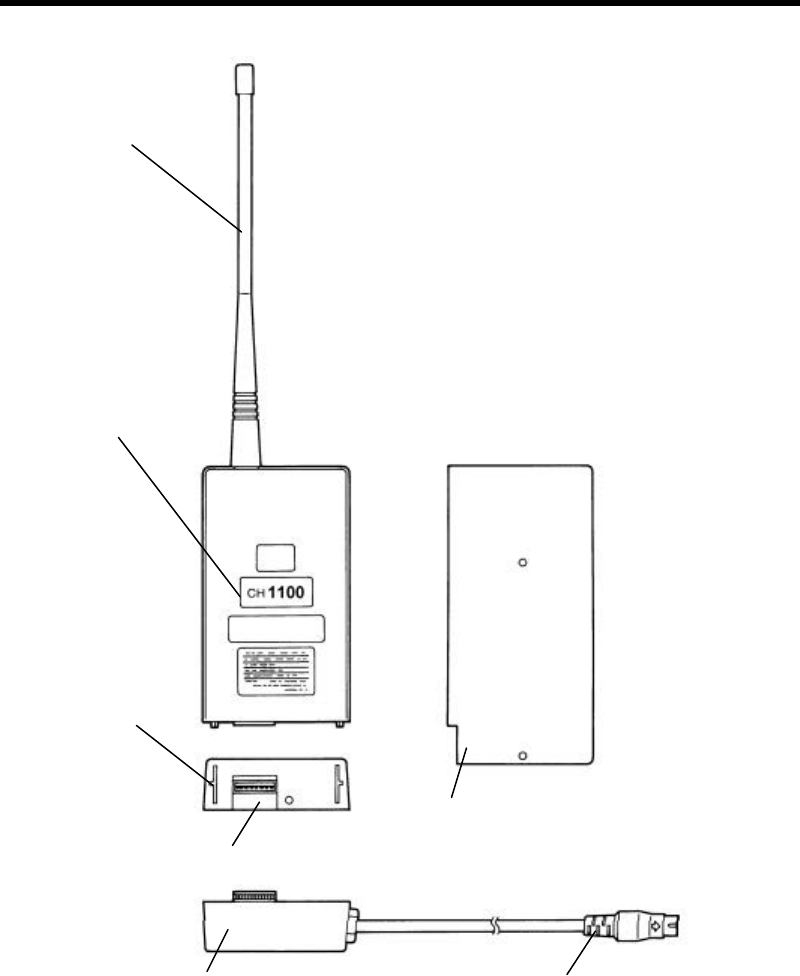
2
2. Controls and Indicators
Antenna
Channel Label
Connector
Wire Adapter Mounting Hole
Mounting Fixture (option)
Wire Adapter (option) Connector (option)
3
Antenna
Transmitting antenna for the physiological parameters.
Channel Label
Contains the channel identification number of the transmitter. The
receiver must be set to the same channel number. If the channel
number is changed, the channel label must be replaced.
Connector
Connects to the bedside monitor.
Wire Adapter Mounting Hole
Connects to the optional wire adapter OA-287.
Wire Adapter OA-287 (option)
Allows for mounting the HLX-561 onto a bedside monitor.
Connector (option)
Allows for external connection of the HLX-561 to the bedside monitor.
Connect to the F-LINK connector of the bedside monitor.
Mounting Fixture (option)
For mounting the HLX-561 into the bedside monitor. The illustration
shows the method for mounting to the DS-5300.
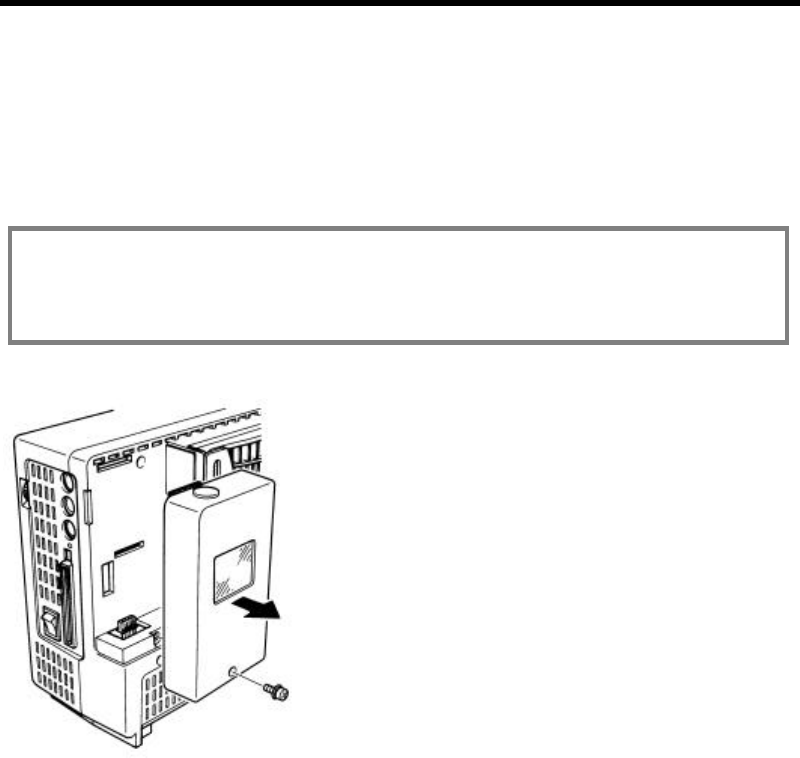
4
3. Mounting the HLX-561 to the Bedside Monitor
Described here are the procedures for mounting the HLX-561 to the
DS-5100 and DS-5300 as typical bedside monitors. If the radio channel
is changed, it is recommended the channel label be changed in advance.
Mounting to the DS-5100
NOTE: Before starting the mounting work, turn the main
power switch on the DS-5100 OFF and disconnect the
power cable from the wall outlet.
The transmission module
housing is located at the
upper left of the DS-5100 as
viewed from the rear.
Remove
the screw that holds
the cover in place and
remove the cover as shown.
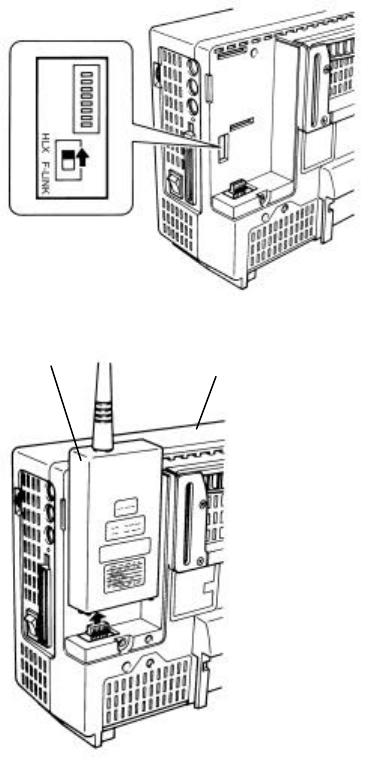
5
F-LINK/HLX
Switch
The F-LINK / HLX switch is
now accessible. Switch to
the HLX position to effect
internal communication
(Setting this switch to the
HLX position disables the
external F-LINK
connector.)
Connect the cable from the
bottom of the module
housing
to the connector at
the bottom of the
HLX-56
1. Remove the cap
which covers the antenna
hole in the top of HLX-
561
transmission module
housing cover.
Place the HLX-561 into the
housing, taking care not to
jam the cable in the inside.
HLX-561
DS-5100 Rear panel
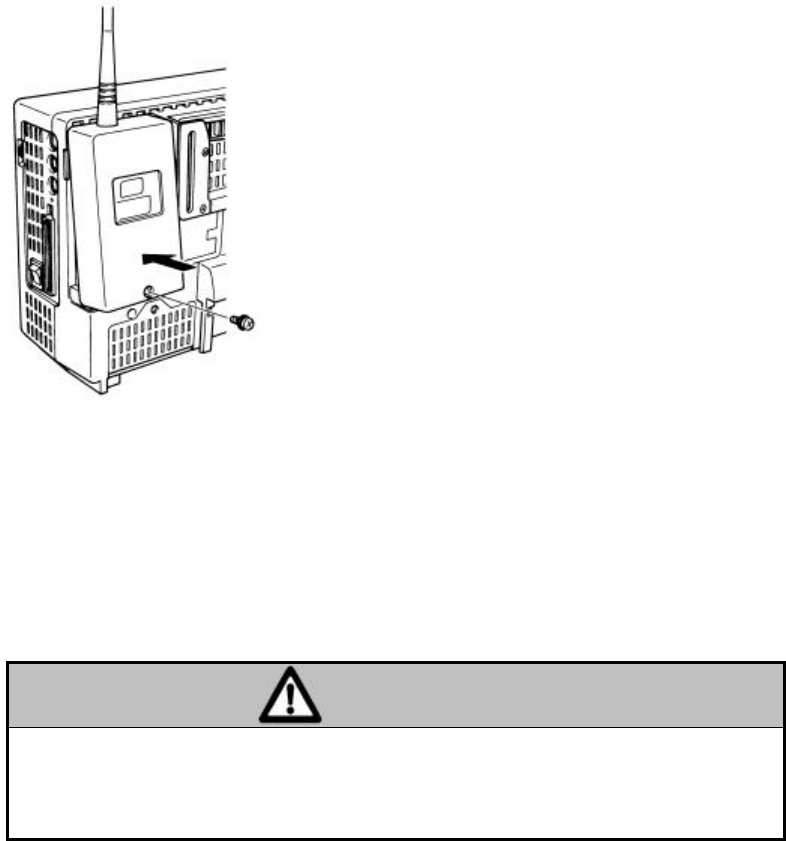
6
Reconnect the power cord and turn the DS-5100 ON. Set the
telemetry channel from the telemetry set-up display on the
DS-5100.
For details in selecting the telemetry channel, refer to the operation
manual for the DS-5100.
WARNING
Operation of this equipment requires the prior coordination
with a frequency coordinator designated by the FCC for the
Wireless Medical Telemetry Service.
To check the system, and verify proper transmission from the
HLX-561 to the telemetry receiver, check the central receiver and
monitor to ensure the waveforms and alphanumeric data are
properly displayed.
The wireless network system is now functioning properly.
Place the cover back in its
original position while at the
same time inserting the
antenna into the antenna
hole. Replace the cover
onto
the DS-5100 by replacing
the screw at the bottom.
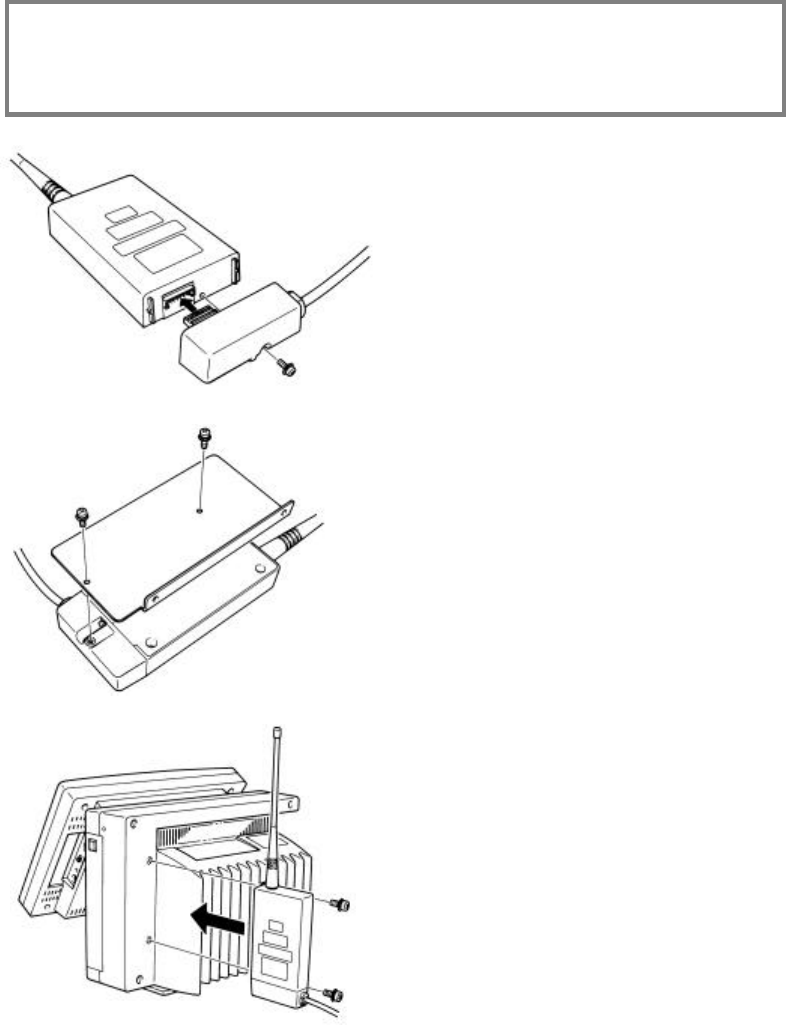
7
Mounting into the DS-5300
NOTE: Before starting, be sure to turn the main power switch
of the DS-5300 OFF and disconnect the power cable
from the wall outlet.
Connect the optional
OA-287 adapter to the
HLX-561, connector to
connector. Attach the
adapter to the HLX-561
with the accessory screw
(M2.6 x 8).
Attach the optional
mounting fixture onto
the HLX-561 with two
accessory screws (M2.6
x 6).
Attach the assembly
consisting of the
HLX-561, OA-287 and
mounting fixture, to the
DS-5300 with the two
accessory screws (M3 x
6).
HLX-561
OA-287
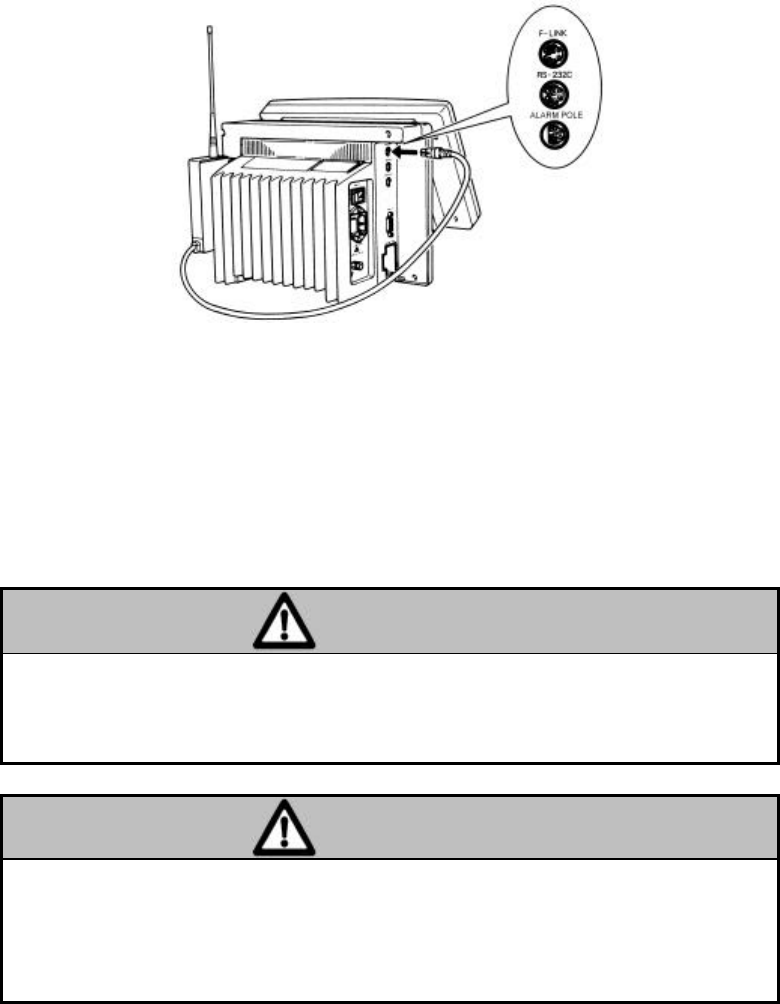
8
Connect the cable from the OA-287 to the F-LINK connector of
DS-5300.
Reconnect the power cord and turn the DS-5300 ON. Select the
telemetry channel from the telemetry set-up display on the
DS-5300.
For details on the telemetry channel set-up procedure, refer to the
operation manual for to the DS-5300.
WARNING
Operation of this equipment requires the prior coordination
with a frequency coordinator designated by the FCC for the
Wireless Medical Telemetry Service.
WARNING
Setting or changing the telemetry channel may cause
interference with another telemetry system. Be sure to consult
engineering for telemetry channels to select the proper radio
channel which does not cause interference.
9
To check the system, and verify proper transmission from the
HLX-561 to the telemetry receiver, check the central receiver and
monitor to ensure the waveforms and alphanumeric data are
properly displayed.
The wireless network system is now functioning properly.

10
4. Setting the Receiving Channel of the Monitor
Select the telemetry receiver channel to match that of the telemetry
transmission module. The monitor will display the channel number. If
the transmission module has a different group code than that of the
receiver, set the telemetry receiver group code to correspond to the
telemetry transmission module. (For details on selecting the channel
and group code, refer to the operation manual for the appropriate
monitor.)
If the selected channel number does not correspond to the frequency
that is actually received, an alarm waveform will be displayed to alert
the staff to interference (see example below).
NOTE: The interference prevention function is not effective
unless the receiver has the interference detection
function.
Verify the receiver has the interference detection
function and the proper channel number set.
Example of display on the DS-5800NX central monitor
INTERFERENCE
message with alarm

11
5. Cleaning, Sterilization and Disinfection
Clean, sterilize and disinfect the HLX-561 and accessories as follows.
Cleaning
Use a clean, soft cloth dampened with alcohol or a weak
acid/alkalescent/neutral cleanser. Clean the HLX-561 and accessories
with the dampened cloth, taking care that the cleaning solution does not
enter into any connectors or get inside the HLX-561.
Do not use cleaning agents containing organic solutions, thinner,
toluene and benzene. Such chemical solutions may damage the resin
casing.
Sterilization and Disinfection
For Disinfection, wipe the HLX-561 and accessories using a gauze or
sanitary cotton moistened with inert soap or alcohol. Do not moisten
allow moisture inside of the connector to avoid contact failure.
For sterilization, use a gas sterilization method. Sterilization methods
utilizing high temperatures such as an autoclave will damage the
HLX-561 and accessories.
If sterilizing the room utilizing spray chemical solution methods, take
proper measures to ensure the chemical solution will not contact the
inside of the HLX-561 and connectors.

12
6. Maintenance and Inspection
To maintain the safety and reliable functionality and performance of the
HLX-561, it is preferable to perform routine and periodic inspections
before use. A recommendation is described in this section. Failure to
perform routine maintenance and inspection may void the
responsibility of Fukuda Denshi.
CAUTION
Persons other than your authorized Fukuda Denshi service
representative must not remove the external casing of the
HLX-561.
Always take care to avoid spilling alcohol or any other liquids
inside of the HLX-561.
Routine Inspection
It is recommended that a routine inspections be performed daily. A
sample Routine Inspection Record is provided on the next page.
Periodical Inspection
Periodic inspections are necessary to prevent trouble and accidents and
to maintain the safety and efficacy of medical electrical equipment.
Ensure normal operation of the equipment by correcting adverse
environmental conditions, if any, and by keeping the equipment in good
repair. Periodic inspection becomes a part of the maintenance and
inspection to ensure the equipment operates properly, efficiently, and
safely.
Periodic inspection may be conducted by either the user or an
authorized Fukuda Denshi service representative.
For details, contact your Fukuda service representative.

13
Routine Inspection Record
No.
Inspection Date: Inspected by: Location:
Model: HLX-561 Serial No.: Purchase Date:
Items Inspection Judgement criteria Judgement
External
appearance
Check the external
appearance for scratches,
breaks, cracks, loose
screws, or labels.
Check the antenna for bends
or breaks.
No abnormalities
Pass/Fail
Function
Under normal operating
conditions, check the
functions at the central
monitor.
Waveforms and data
received in normal
manner.
Pass/Fail
Periodic
Inspection
Check the data of the most
recent inspection. Periodic Inspections
should be performed per
the institutions standard
operating procedures.
Pass/Fail

14
7. Specifications
Transmitting Information (will depend on bedside monitor used)
Waveforms : ECG × 1, 5 additional waveforms (e.g.
Respiration, pulse, 2 blood pressure
waveforms)
Numeric Parameters : NIBP, SpO2, Temp 1, Temp 2, BP1,
BP2, Heart Rate, Respiration Rate, etc.
Status Information : Low Battery, Electrode fail, Group
code (64 types), Alarm, Alarm suspend,
Remote record, Model ID number,
Transmitter channel No.
Interface
Communications Method : RS-232C Serial Interface
Radio Frequency Specification
Modulation Method : Digital, Frequency Shift Keying (FSK)
RF Output Power : −15 dBm Standard, 0 dBm MAX
Transmission Frequency : 608∼614 MHz
Channel spacing : 12.5 kHz
Power Requirements : +5 V, 60 mA supplied from the bedside
monitor

15
Dimensions and Weight
Dimensions : 61.5(W) × 108.5(H) × 20.5(D) mm
Weigh : Approximately 100 grams
Environmental Conditions
Operating Temperature : 10 to 40 °C
Operating Humidity : 30 to 85 %R.H. no dew condensation
Storage Temperature : −10 to 60 °C
Storage Humidity : 30 to 95 %R.H.(at 60 °C)
Specifications subject to change without notice
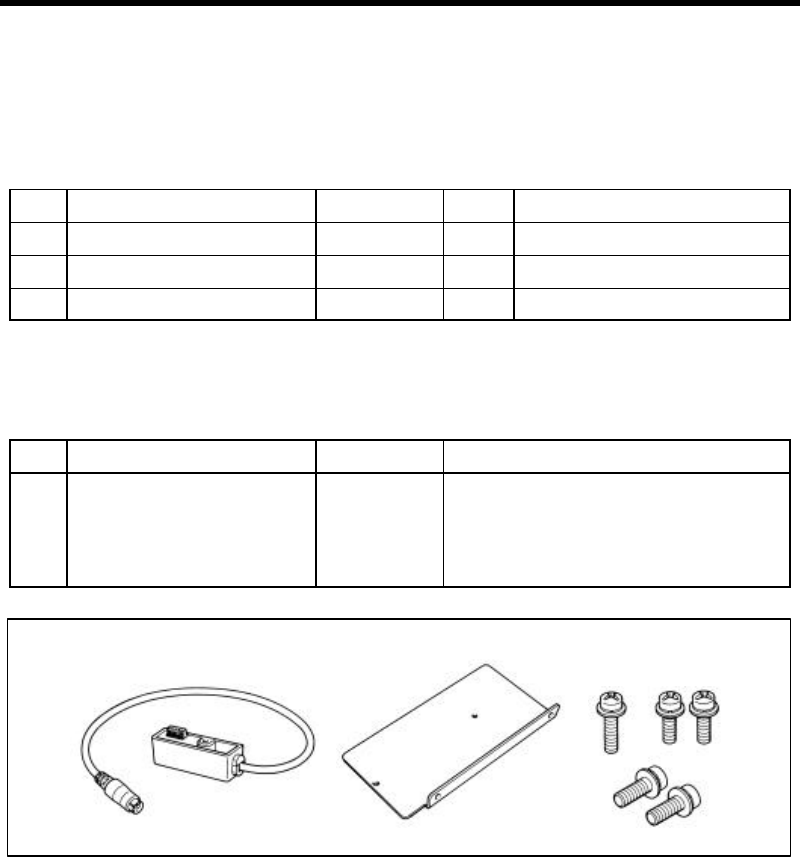
16
8. Accessories
To ensure the HLX-561 will perform to its published specifications, use
only those accessories specified by Fukuda Denshi. When ordering
spare parts or accessories, specify the part name and model number.
Standard Accessories
No. Item Model Q'ty Remarks
Operation Manual 1
Optional Accessories
The following item is not included in standard accessories. Purchase it
separately.
No. Item Model Remarks
Wire Adapter OA-287
Comes complete with the mounting
fixture for the DS-5300 and
mounting screws (M2.6x6 : 2 pcs.
And M3x6 : 2 pcs, all with washer)

Head office : 39-4, Hongo 3-chome, Bunkyo-ku, Tokyo, Japan
Phone : -81-3-3815-2121
Telex : 23498 FUKUMED J
Fax : -81-3-5684-3791
4L2869 200102
E